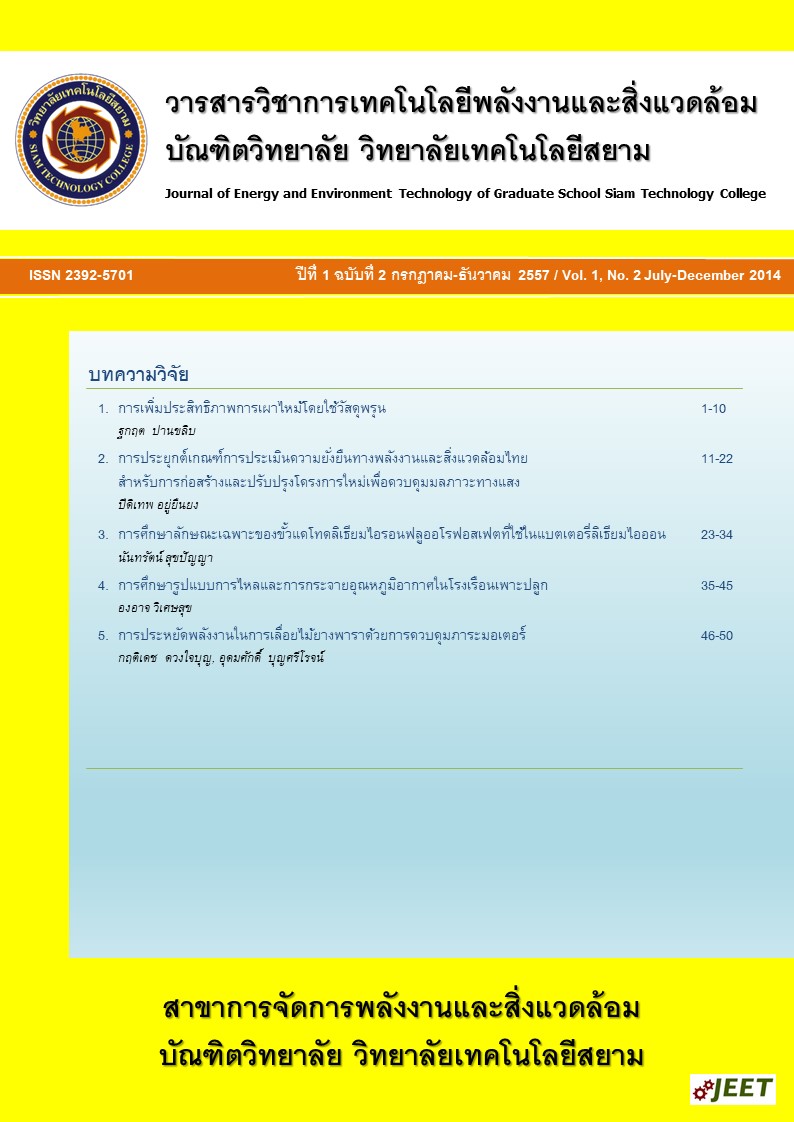การศึกษาลักษณะเฉพาะของขั้วแคโทดลิเธียมไอรอนฟลูออโรฟอสเฟตที่ใช้ในแบตเตอรี่ลิเธียมไอออน
Main Article Content
บทคัดย่อ
บทความนี้ได้ศึกษาลักษณะเฉพาะของลิเธียมไอรอนฟลูออโรฟอสเฟตที่ใช้เป็นขั้วแคโทดในแบตเตอรี่ลิเธียมไอออน โดยลักษณะเฉพาะที่ได้ศึกษาคือการวิเคราะห์โครงสร้างทางจุลภาคและโครงสร้างผลึกก่อนและหลังการชาร์จและดิสชาร์จ การทดสอบความจุของแบตเตอรี่และการทดสอบปฏิกิริยาทางไฟฟ้าเคมี ซึ่งในการศึกษาได้ทำการสังเคราะห์ผงอนุภาคลิเธียมไอรอนฟลูออโรฟอสเฟต (LiFePO4F) ด้วยวิธี Solid-state จากนั้นนำผงที่สังเคราะห์ได้มาศึกษาลักษณะทางโครงสร้างจุลภาคด้วยกล้องจุลทรรศน์อิเล็กตรอนแบบส่องกราด (SEM) และวิเคราะห์โครงสร้างผลึกที่เปลี่ยนไปด้วยเทคนิคการเลี้ยวเบนรังสีเอ็กซ์ (XRD) ทั้งก่อนและหลังการการทดสอบแบตเตอรี่ด้วยการชาร์จและดิสชาร์จแบบใช้กระแสคงที่ (Galvanostatic Charge - Discharge) จากผลการศึกษาพบว่าโครงสร้างผลึกที่เปลี่ยนไปเมื่อทำการเปลี่ยนอัตราการชาร์จจะมีผลต่อความจุของแบตเตอรี่ โดยเมื่อทดสอบด้วยอัตราการชาร์จ 0.5C และ 2C จะมีความจุแบตเตอรี่ในตอนดิสชาร์จครั้งแรก 129 mAh/g และ 102 mAh/g ตามลำดับ และเมื่อทดสอบการชาร์จและดิสชาร์จแบตเตอรี่เป็นจำนวน 30 รอบจะเหลือความจุแบตเตอรี่ 114 mAh/g และ 63 mAh/g หรือเหลือความจุเพียง 88% และ 61% ตามลำดับ นอกจากนี้ยังศึกษาถึงประสิทธิภาพทางไฟฟ้าเคมีของแบตเตอรี่ด้วยเทคนิค Cyclic Voltammetry เพื่อดูการเกิดปฏิกิริยาและการแพร่กระจายของลิเธียมไอออนในเซลล์แบตเตอรี่ จากผลการศึกษาพบว่าแบตเตอรี่ที่ใช้ขั้วแคโทด LiFePO4F จะเกิดปฏิกิริยาที่แรงดัน 2.75V และมีการแพร่กระจายของลิเธียมไอออนภายในแบตเตอรี่ 1.05x10-13 cm2/s
Article Details
เนื้อหาและข่อมูลในบทความที่ลงตีพิมพ์ในวารสารวิชาการ เทคโนโลยี พลังงาน และสิ่งแวดล้อม บัณฑิตวิทยาลัย วิทยาลัยเทคโนโลยีสยาม ถือเป็นข้อคิดเห็นและความรับผิดชอบของผู้เขียนบทความโดยตรง ซึ่งกองบรรณาธิการวารสารไม่จำเป็นต้องเห็นด้วย หรือว่าร่วมรับผิดชอบใด ๆ
บทความ ข้อมูล เนื้อหา รูปภาพ ฯลฯ ที่ได้รับการตีพิมพ์ในวารสารวิชาการ เทคโนโลยี พลังงาน และสิ่งแวดล้อม บัณฑิตวิทยาลัย วิทยาลัยเทคโนโลยีสยาม ถือเป็นลิขสิทธิ์ของวารสารวิชาการ เทคโนโลยี พลังงาน และสิ่งแวดล้อม บัณฑิตวิทยาลัย วิทยาลัยเทคโนโลยีสยาม หากบุคคล หรือหน่วยงานใดต้องการนำทั้งหมด หรือส่วนหนึ่งส่วนใดไปเผยแพร่ต่อ หรือเพื่อกระทำการใด ๆ จะต้องได้รับอนุญาต เป็นลายลักษณ์อักษรจากวารสารวิชาการ เทคโนโลยี พลังงาน และสิ่งแวดล้อม บัณฑิตวิทยาลัย วิทยาลัยเทคโนโลยีสยาม เท่านั้น
เอกสารอ้างอิง
2.Ellis, B.L., Makahnouk, W.R.M., Makimura, Y., Toghill, K. and Narzar, L.F., 2007, A Multifunctional 3.5 V Iron-Base Phosphate Cathode for Rechargeable Batteries, Nature Materials, Vol. 6, pp. 749-753.
3.T.N. Ramesh, K.T. Lee, B.L. Ellis and L.F. Nazar, Tavorite Lithium Iron Fluorophosphate Cathode materials: Phase Transition and Electrochemistry of LiFePO4F – Li2FePO4F, Electrochem. Solid-State Lett.,2010, 13, A43 - A47.
4.Prabu, M., Reddy, M.V., Selvasekarapandian., Subba Rao, G.V. and Chowdari, B.V.R., 2012,
“Synthesis, Impedance and Electrochemical Studies of Lithium Iron Fluorophosphate, LiFePO4F
Cathode”, Electrochimica Acta, Vol.85, pp. 572-578
5.นันทรัตน์ สุขปัญญา. (2556). การศึกษาโครงสร้างและความจุของแบตเตอรี่ลิเธียมไอออนที่ใช้ LiFePO4F เป็นขั้วแคโทด, รายงานสืบเนื่องจากการประชุมวิชาการระดับนานาชาติ การวิจัยระดับบัณฑิตศึกษาแห่งประเทศไทย ครั้งที่ 30, 59-69
6.Dahlin, G.R. 2010, Lithium Batteries Research, Technology and Applications, Nova Science Publishers,Inc., New York, pp. 2-3, 23, 32-34, 37, 52-54, 59-60.
7.Huang, B., Lui, S., Li, H., Zhuang, S. and Fang, D., 2012, “Comparative Study and Electrochemical Properties of LiFePO4F Synthesis by Different Routes”, Bulletin of the Korean Chemical Soceity, Vol.33, pp. 2315-2319.
8.Recham, N., Chotard J.N., Dupont L., Delacourt, C., Walker, W., Armand, M. and Terascon, J.M., A 3.6 V Lithium-Based Fluorosulphate Insertion Positive Electrode for Lithium-ion Batteries, Nat. Mater, 2009, 9, 68-74
9.J. Choi, A Manthiram.,Investigation of the Irreversible Capacity Loss in the Layered LiNi1 ∕ 3Mn1 ∕ 3Co1 ∕ 3O2 cathode, Electrochemical and solid-state letter8, 2005, C102.


